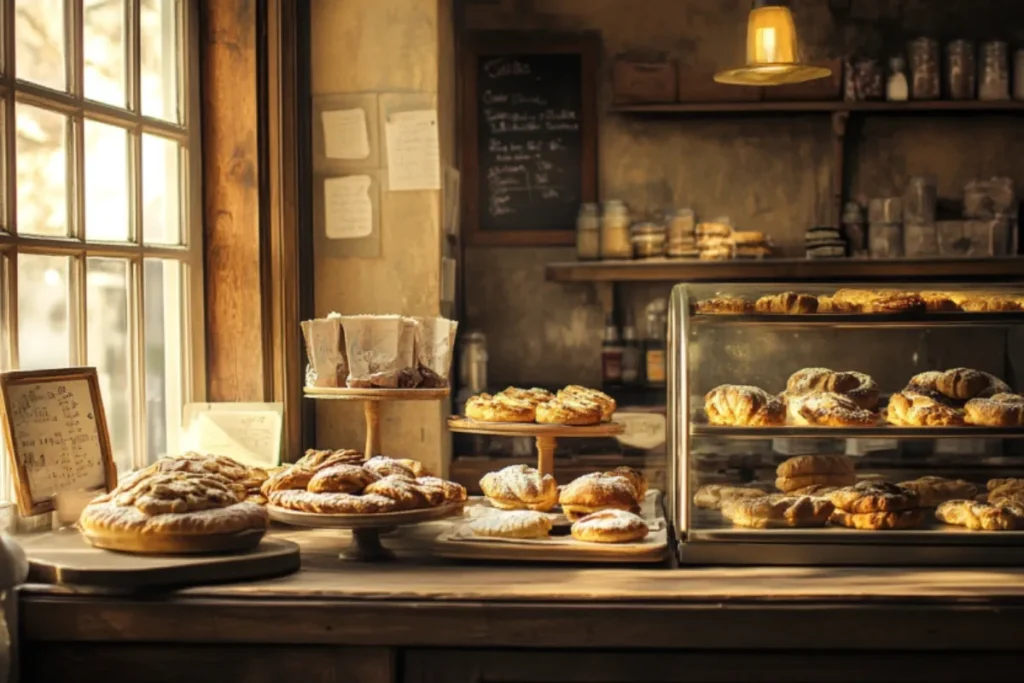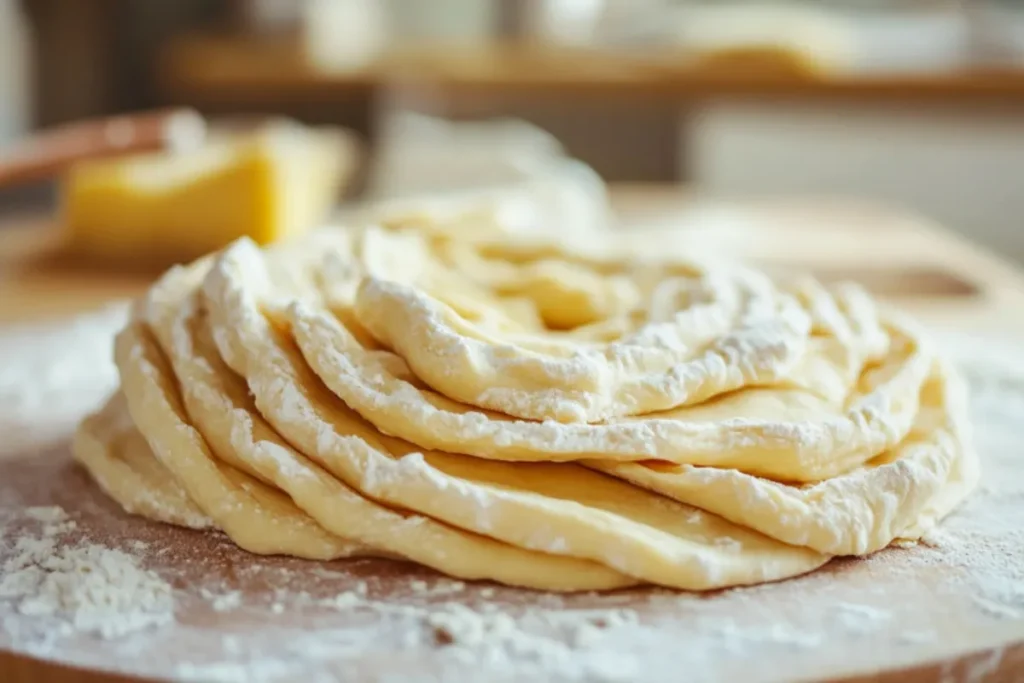A simple and delicious pastry that has won the hearts of many around the world. If you’ve ever enjoyed a warm, flaky cheese Danish with a soft, creamy filling, you know exactly why these pastries are so popular. This easy Cheese Danish recipe will show you how to recreate these iconic treats in your own kitchen. For a healthier treat using fruit, try one of these healthy fruit recipes from Healthline. Whether you’re a beginner or a seasoned baker, making a perfect cheese Danish is easier than you think!
What is a Cheese Danish?

A Cheese Danish is a sweet, yeast-leavened pastry made with layers of buttery, flaky dough and a rich cream cheese filling. Sometimes glazed or topped with fruit preserves, this pastry can be served warm or at room temperature, making it a versatile treat for any occasion. Typically, you’ll find them in a variety of shapes—some are rolled, others are folded, and some even come in twists. But no matter the form, each bite delivers a satisfying balance of sweetness, tanginess, and richness.
Overview of a Cheese Danish
The Cheese Danish is known for its delicate layers of dough, which are created by folding butter into the dough multiple times, similar to the technique used in puff pastry. This results in the signature crispiness and flakiness. The cheese filling is typically made with cream cheese, offering a tangy contrast to the sweetness of the dough. To enhance flavor, ingredients like lemon zest, vanilla, and sugar may be added to the filling, while a simple glaze can finish the pastry off with a sweet shine.
While you can find Cheese Danish in bakeries worldwide, the pastry is particularly popular in Denmark, the United States, and various European countries. Despite its global popularity, its origins and history are fascinating and offer a deeper understanding of the treat’s journey.
History and Origins of the Cheese Danish

Though the Cheese Danish is a beloved pastry around the world, it was actually inspired by a variation of Danish pastries that originated in Denmark. The Danish pastry dough is said to have been brought to the United States by Danish immigrants in the 19th century. However, there’s an interesting twist to the story. The reason it’s often called a “Danish” is due to the way it was popularized in the U.S.
In the mid-1800s, during a strike in Vienna, Austrian bakers were unable to bake their famous pastries. As a result, Danish bakers stepped in to fill the void. The Danish pastry quickly gained popularity in both Denmark and abroad, and its puffed, buttery layers became iconic. Over time, various fillings like almond paste, chocolate, and cheese were added, with the cheese filling becoming one of the most common variations.
In the U.S., the Danish was transformed into a slightly sweeter, less flaky version, which we now recognize as the Cheese Danish. Today, many bakery versions of the pastry are stuffed with a thick cream cheese filling, making them a true treat for lovers of both sweet and savory flavors.
Traditional Ingredients of Cheese Danish
To create a traditional Cheese Danish, you’ll need a few key ingredients:
- Pastry dough: This could either be puff pastry or Danish pastry dough, depending on the recipe.
- Cream cheese: The main ingredient for the filling, giving the Danish its rich and tangy flavor.
- Sugar: To sweeten the filling and sometimes the dough itself.
- Eggs: Used to bind the filling together and add richness.
- Butter: Essential for the dough to achieve that signature flaky texture.
- Vanilla or lemon zest: For an extra boost of flavor in the filling.
- Glaze: Often, a light glaze made of powdered sugar, vanilla, and milk is drizzled over the pastry to add sweetness and shine.
Why Cheese Danish is Popular
The Cheese Danish is one of those timeless pastries that never seems to lose its charm. Whether served at breakfast, as a snack, or as a dessert, there’s something about its combination of crispy pastry and rich, tangy filling that hits just right. But what makes the Cheese Danish so beloved across cultures and generations?
In addition to making a Cheese Danish recipe, if you’re looking for other delightful pastries or breakfast ideas, check out our Cottage Cheese Bagels Recipe for another tasty and nutritious option. You can also try making Easy Pumpkin Muffins with Cake Mix if you’re in the mood for a comforting, fall-inspired treat!
For those who love to experiment with flavors, consider pairing your Cheese Danish with a Salmon Breakfast Idea for a healthy and protein-packed start to your day. And if you’re craving something savory instead, check out our Deviled Egg Pasta Salad Recipe for a refreshing and satisfying side dish.
The Appeal of Sweet and Savory Flavors
One of the biggest draws of the Cheese Danish is its ability to blend both sweet and savory flavors in one delicious bite. The cream cheese filling brings a tangy richness that perfectly balances the sweet dough. Plus, the buttery, flaky layers of pastry add a savory contrast that makes it so satisfying. Whether you’re looking for a little sweetness to start your day or a decadent treat to enjoy with your afternoon coffee, the Cheese Danish has got you covered.
Variations in Cheese Danish Around the World

The beauty of the Cheese Danish is that it has been adapted and embraced by various cultures across the globe. Although the classic Cheese Danish is often associated with Denmark, you can find similar pastries in many countries, each with its own spin on the recipe. For instance, in Sweden, a variation called the “Kardemummabullar” features cardamom-flavored dough and a cheese filling. Meanwhile, in Poland, you might encounter a Cheese Danish with a slightly more bread-like dough, often paired with a fruit topping.
Danish vs American Versions of Cheese Danish
The Danish and American versions of the Cheese Danish differ in a few notable ways. In Denmark, the traditional Danish pastry dough (which is yeast-leavened) tends to be lighter and flakier. This type of dough is labor-intensive, but it results in a lighter, more delicate texture. On the other hand, the American version of the Cheese Danish often uses puff pastry, which is quicker and easier to work with, though it results in a denser, slightly more buttery texture.
The Role of Cheese in Danish Pastries
Cheese is a central ingredient in many Danish pastries, not just in the Cheese Danish but in others like the Danish with almond paste or fruit. The use of cream cheese in the Danish pastry helps to create a filling that is both indulgent and slightly tangy, offering a great contrast to the sweetness of the dough. This combination of flavors is one of the key factors that makes the Cheese Danish so irresistible.
The cheese used in these pastries is typically cream cheese, but some variations include ricotta or mascarpone for a different flavor profile. Ultimately, it’s the creamy, slightly tangy cheese that makes these pastries so satisfying and unique.
Essential Ingredients for Making a Cheese Danish
Creating a perfect Cheese Danish requires a handful of key ingredients that come together to create the signature combination of flaky pastry and tangy cream cheese filling. Whether you’re using store-bought puff pastry or making your own Danish dough from scratch, knowing which ingredients are essential will set you on the path to pastry perfection. Let’s break down the most important elements that go into making a Cheese Danish, so you can approach your baking project with confidence.
Cheese Choices for Danish Pastry Filling
The cheese filling is undoubtedly the star of a Cheese Danish, and the type of cheese you use will directly impact the flavor and texture of your pastry. While many people automatically think of cream cheese, the choice of cheese can vary depending on regional preferences, or even your taste buds!
Types of Cheese Commonly Used in Cheese Danish
- Cream Cheese: This is the most common cheese used in Cheese Danish. Its smooth, creamy texture and slightly tangy flavor make it the perfect base for the filling. Cream cheese also blends well with other flavorings like lemon zest, vanilla, and sugar.
- Ricotta Cheese: For a lighter, more delicate filling, ricotta cheese can be used. It offers a softer, slightly sweeter flavor compared to cream cheese and works well if you’re looking for a less tangy option.
- Mascarpone Cheese: Often used in Italian desserts, mascarpone provides a rich, velvety filling with a slightly sweet flavor. It can be used on its own or mixed with cream cheese for a more luxurious texture.
- Neufchâtel Cheese: Similar to cream cheese but lower in fat, Neufchâtel offers a lighter option while still giving you that familiar tangy flavor.
You might even consider mixing two or more types of cheese to create a custom filling. For instance, combining cream cheese with ricotta or mascarpone can give the filling a perfect balance of creaminess and texture.
Substituting Cheese in a Cheese Danish Recipe
If you’re not a fan of cream cheese or simply want to try something different, there are several substitutes you can use. For instance, if you prefer a dairy-free option, plant-based cream cheese works well in most recipes. Alternatively, for those looking for a lower-fat filling, you can swap in low-fat ricotta or cottage cheese.
If you’re feeling adventurous, some people like to add flavored cheeses, like goat cheese or even blue cheese, for a unique twist. Just keep in mind that stronger cheeses will alter the flavor of the Danish, so it’s important to choose a cheese that complements the other ingredients.
Pastry Dough: Puff Pastry vs Danish Pastry
One of the main components of a Cheese Danish is, of course, the pastry dough. While many people automatically think of puff pastry, there is a difference between puff pastry and Danish pastry dough. Understanding this difference will help you decide which one works best for your recipe.
The Difference Between Puff Pastry and Danish Pastry
- Puff Pastry: Puff pastry is a type of dough made by layering butter between thin sheets of dough, then rolling and folding the dough repeatedly. This process creates layers that “puff up” when baked. Puff pastry is buttery and flaky, but it is generally less sweet than Danish pastry dough. It’s also quicker and easier to work with, making it a popular choice for home bakers.
- Danish Pastry: Danish pastry dough is also buttery and flaky, but it includes yeast, which helps the dough rise during baking. The yeast gives the Danish pastry dough a slightly bread-like texture, making it a bit more substantial than puff pastry. This dough takes more time and effort to prepare, but the result is a soft, pillowy interior with a crisp, golden crust.
While both doughs can be used to make a Cheese Danish, if you’re after a lighter, flakier pastry, puff pastry is a good option. If you prefer a more traditional, bread-like texture with a delicate chew, Danish pastry dough is the way to go.
Other Key Ingredients: Sugar, Egg, and Butter
While the cheese and pastry dough take center stage in a Cheese Danish, other ingredients like sugar, eggs, and butter play crucial supporting roles in creating a perfectly balanced pastry.
- Sugar: Sugar sweetens the dough and filling, giving the Cheese Danish its signature dessert-like quality. Some recipes also use sugar to make a glaze, adding a glossy finish that enhances the overall presentation.
- Eggs: Eggs are often used in the filling to help bind the ingredients together. They also add richness and contribute to the slightly custardy texture of the filling.
- Butter: Butter is essential for creating the flaky, tender layers in the dough. It’s the fat that gives both puff pastry and Danish pastry their rich, buttery flavor. Without butter, you’d miss out on the luxurious texture that makes Cheese Danish so irresistible. Additionally, butter is often brushed onto the pastries before baking to help them achieve that golden, crispy finish.
Step-by-Step Guide to Making a Cheese Danish

Now that you’ve got a grasp on the essential ingredients, let’s move on to the fun part: actually making a Cheese Danish! While it may seem like a complicated pastry to prepare, the process is relatively simple, especially if you opt for store-bought puff pastry. Here’s a step-by-step guide to making your own Cheese Danish from scratch or with a few shortcuts.
Preparing the Pastry Dough
If you’re using store-bought puff pastry, the first step is to thaw it according to the package instructions. If you’re making Danish pastry dough from scratch, you’ll need to prepare the dough by mixing flour, yeast, sugar, butter, milk, and eggs. Once the dough is made, you’ll need to let it rise before rolling it out into thin sheets.
No matter which dough you choose, the key is to roll it out as evenly as possible so the layers form consistently when baked. If you’re using puff pastry, you may want to roll it slightly thinner to achieve a more delicate texture. If you’re making Danish dough, make sure to fold it and let it rest between folds so that the layers are built up.
Making the Cream Cheese Filling
For the cream cheese filling, start by softening your cream cheese (or any other cheese you’re using) to room temperature. This will make it easier to mix and ensure a smooth, lump-free filling. Once soft, combine the cream cheese with sugar, vanilla extract, lemon zest, and a pinch of salt. You can also add a bit of egg to help bind the filling together and give it that creamy, custard-like texture. Mix everything until it’s well combined.
Flavoring the Cream Cheese Filling with Zest and Spices
To elevate the flavor of the filling, consider adding a little zest of lemon, orange, or lime. Spices like cinnamon or nutmeg can also be added to create a more festive, aromatic filling. This is where you can get creative and adjust the flavor profile to your liking.
Assembling and Baking the Cheese Danish
Once the dough is prepared and the filling is ready, it’s time to assemble your Cheese Danish. For traditional folded shapes, cut the dough into squares, place a spoonful of the cheese filling in the center, and fold the corners over the filling. You can also opt for twists or braided shapes for a fun twist.
For baking, brush the pastries with an egg wash to give them a golden, shiny finish. Bake in a preheated oven at 375°F (190°C) for about 20–25 minutes, or until the pastries are golden and puffed up. Once done, let them cool slightly, then drizzle with glaze (if desired).
Baking Techniques for a Perfect Cheese Danish
Achieving that perfect golden, flaky crust is all about timing and temperature. Make sure to bake your Cheese Danish in a preheated oven to ensure even cooking. If you’re using puff pastry, don’t skip the egg wash—it will help the pastries brown evenly and achieve that crisp texture. Keep a close eye on them towards the end of baking, as overbaking can lead to a dry pastry.
Tips and Tricks for Perfecting Your Cheese Danish
While making a Cheese Danish is fairly straightforward, a few tips and tricks can take your baking game to the next level. After all, it’s all about getting that perfect balance of flaky pastry, creamy filling, and a golden, crispy finish. Whether you’re a beginner or an experienced baker, these suggestions can help ensure your Danish turns out delicious every time.
- Chill Your Dough: If you’re working with homemade dough, it’s essential to chill it before baking. Chilled dough holds its shape better and creates flakier layers when baked. This is especially important for puff pastry, which relies on layers of butter to puff up properly.
- Don’t Overfill: While it’s tempting to load up the center with lots of filling, less is more. Overfilling can cause the cheese to spill out during baking, making a mess and potentially undercooking the dough. A tablespoon or two of filling per pastry is usually plenty.
- Brush with Egg Wash: For that shiny, golden finish, brush your assembled Cheese Danish with an egg wash (a mixture of beaten egg and water or milk) before baking. This also helps the pastries brown evenly.
- Baking Sheet Lining: Always line your baking sheet with parchment paper to prevent the pastry from sticking and to make cleanup easier. This also helps to ensure that the pastries cook evenly.
- Don’t Rush the Baking: Give your Cheese Danish the time it needs to bake fully. If the pastry is still pale after 20 minutes, give it a few extra minutes to get that golden color. However, be careful not to overbake, as this could result in a dry, tough pastry.
By following these tips, you’ll be able to achieve bakery-quality Cheese Danish right at home, no matter your skill level.
How to Store and Serve Cheese Danish
Once your Cheese Danish is baked, you might find yourself with leftovers (though they’re so good, that’s unlikely!). Knowing how to store your pastries properly is key to keeping them fresh and delicious for longer.
Can You Freeze a Cheese Danish?
Yes! Freezing Cheese Danish is a great way to save them for later. To freeze them, first allow them to cool completely after baking. Then, wrap each pastry individually in plastic wrap or aluminum foil and place them in a freezer-safe bag. They can be stored in the freezer for up to 2–3 months.
When you’re ready to enjoy them, simply thaw at room temperature or reheat them in the oven to restore their crispness.
Best Way to Reheat a Cheese Danish
Reheating Cheese Danish properly is crucial to keeping that flaky texture intact. The microwave can make the pastry soggy, so it’s best to reheat them in the oven. Preheat the oven to 350°F (175°C) and bake for 10–12 minutes, or until the pastry is heated through and crispy again. If you’re reheating frozen Danish, increase the baking time by about 5–10 minutes.
Maintaining Crispiness After Freezing
The key to maintaining the crispy texture of a Cheese Danish after freezing is to avoid microwaving it. Instead, always opt for reheating in the oven. Wrapping the pastries in aluminum foil while baking can also help retain moisture without sacrificing that signature crispiness. If you’ve got a toaster oven, it’s also a good alternative for reheating single pastries without overcooking them.
Cheese Danish for Special Occasions
One of the best things about Cheese Danish is how versatile it is. Whether you’re making a batch for a casual breakfast or serving it as part of a festive brunch, this pastry is perfect for any occasion. Let’s dive into a few ways you can incorporate Cheese Danish into different events and gatherings.
Serving Cheese Danish at Breakfast or Brunch
Cheese Danish is the ultimate breakfast pastry. It pairs wonderfully with a hot cup of coffee or tea and is perfect for lazy weekends or holiday mornings. If you’re hosting a brunch, adding a plate of fresh, flaky Cheese Danish will elevate your spread. You can even serve them alongside other pastries like cinnamon rolls or fruit-filled croissants for a more diverse breakfast buffet.
Pairing Cheese Danish with Coffee or Tea
The rich, buttery texture of a Cheese Danish pairs beautifully with a cup of coffee or tea. Whether you prefer a strong espresso or a light herbal tea, the flavors of the pastry complement almost any type of hot drink. If you want to get really fancy, you can even serve a selection of flavored coffees, like vanilla latte or caramel macchiato, to complement the sweet and tangy cheese filling.
Cheese Danish as a Dessert Option
Although Cheese Danish is often served for breakfast or brunch, it can also be enjoyed as a dessert. When served at the end of a meal, especially with a drizzle of sweet glaze or a sprinkle of powdered sugar, it makes for a delightful treat. For a more decadent dessert, consider pairing your Danish with a scoop of vanilla ice cream or a dollop of whipped cream.
Summary and Final Thoughts on Cheese Danish
There’s no denying that a fresh, homemade Cheese Danish is a delightful treat. Whether you opt for a simple cream cheese filling or add your own twist with different flavors and spices, it’s a pastry that never goes out of style. The combination of buttery, flaky pastry with creamy, tangy cheese makes for an irresistible dessert or breakfast item.
Making a Cheese Danish at home might seem like a daunting task at first, but with the right ingredients, a little patience, and some simple techniques, you can recreate this classic pastry in your own kitchen. It’s a fun and rewarding baking project that will impress your family and friends—and possibly become a staple in your baking repertoire!
If you’re still on the fence about trying it out, let me just say: there’s nothing like the smell of freshly baked Danish wafting through the house. Plus, it’s totally worth it to see that golden, crispy pastry, and take that first perfect bite.
So, what are you waiting for? Get baking and treat yourself (and your loved ones) to a delicious homemade Cheese Danish!
FAQs
What cheese is in the Starbucks Cheese Danish?
The Starbucks Cheese Danish typically contains a sweetened cream cheese filling. This filling is made from a mixture of cream cheese, sugar, and sometimes vanilla extract, which creates a rich, tangy flavor. Some variations may include a hint of lemon zest or other citrus to balance the richness. While the exact recipe is proprietary, this basic combination is what gives the Danish its signature creamy texture and slightly tangy flavor.
What’s the difference between puff pastry and danish pastry?
The key difference between puff pastry and Danish pastry lies in the dough itself. Puff pastry is made with a simple dough consisting of flour, water, and butter, which is rolled and folded multiple times to create thin, flaky layers. In contrast, Danish pastry dough includes yeast and eggs, giving it a slightly sweet flavor and a more bread-like texture. Danish dough is often laminated, similar to puff pastry, but its yeast content results in a softer, chewier texture.
Thus, while both pastries share a flaky texture, Danish pastry tends to be slightly richer and sweeter due to the added ingredients. Puff pastry, on the other hand, has a more neutral flavor, making it perfect for both savory and sweet dishes.
Can Cheese Danish be frozen?
Yes, Cheese Danish can be frozen. To freeze, first allow the Danish to cool completely after baking. Then, wrap them tightly in plastic wrap or aluminum foil and place them in a freezer-safe bag or container. Frozen Danish can be stored for up to 2–3 months. When you’re ready to enjoy them, simply thaw at room temperature or reheat in the oven to restore the pastry’s crispiness.
To maintain the best texture, avoid microwaving frozen Danish, as this can make the pastry soggy.
How long can a Cheese Danish stay fresh after baking?
Cheese Danish is best enjoyed fresh, but it can stay fresh for up to 2–3 days when stored properly. To store your Danish, place them in an airtight container at room temperature. If you want to extend their freshness, you can refrigerate them, but keep in mind that refrigeration may affect the crispiness of the pastry.
If you’re not able to eat all your Danish within this timeframe, freezing them is a great option. Just make sure to wrap them well and follow the proper reheating techniques to bring back their flakiness.
How do I know when a Cheese Danish is fully baked?
You’ll know your Cheese Danish is fully baked when the pastry is golden brown and crispy, and the cheese filling is bubbly and slightly browned at the edges. It should not feel soft or undercooked in the center. If the pastry appears too pale after the recommended baking time, continue baking for an additional 3–5 minutes, checking frequently to prevent overbaking.
For a golden, flaky crust, make sure you brush the pastries with an egg wash before baking. This step helps to create that perfect golden sheen.
Tips for Achieving a Golden, Flaky Crust
The secret to a golden, flaky crust lies in a few simple techniques. First, always chill the dough before rolling it out. This ensures the butter stays firm and creates the desired flaky texture. Additionally, brushing the Danish with an egg wash (a mixture of beaten egg and water or milk) before baking adds a beautiful golden color and glossy finish.
Also, consider using high-quality butter. It makes a huge difference in both flavor and texture.
What’s the best filling consistency for Cheese Danish?
The ideal filling consistency for a Cheese Danish is creamy yet firm enough to hold its shape during baking. If your filling is too runny, it could cause the pastry to become soggy and leak during baking. To achieve the perfect consistency, blend the cream cheese filling thoroughly with sugar, vanilla, and any other flavorings you choose (like lemon zest). You want a smooth mixture that’s thick enough to stay in the center of the pastry without spilling over.
If the filling seems too soft, you can add a bit of cornstarch or flour to thicken it up, but be sure not to overdo it. A slightly thicker filling will bake perfectly and hold its shape while providing a smooth, creamy texture.
What is the most famous Danish cheese?
One of the most famous Danish cheeses is Danbo. It’s a semi-soft cheese with a mild, buttery flavor and a slightly tangy finish. Danbo is often used in Danish pastries and is a popular choice in Danish sandwiches. Its creamy texture and delicate taste make it a versatile cheese, and it pairs wonderfully with other ingredients like fruits, nuts, and spices.
Another well-known Danish cheese is Havarti. This soft, smooth cheese has a mild flavor and is great for melting. Though it’s less commonly used in pastries like Cheese Danish, it can still be a tasty filling option if you’re looking for a different twist on this classic recipe.
The Role of Danish Cheese in Pastries
Danish cheese plays a significant role in the flavor of pastries like Cheese Danish. The combination of tangy, creamy cheeses like cream cheese, Danbo, or Havarti enhances the overall richness of the pastry while balancing the sweetness of the dough. By using locally sourced Danish cheese, bakers can create an authentic flavor profile that stays true to the origins of this beloved pastry.

